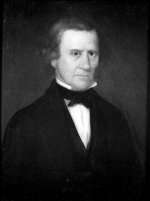Cephas Washburn

Cephas Washburn (1793–1860) was a noted Christian missionary and educator who worked with the Cherokee of northwest Arkansas and eastern Oklahoma. He is often referred to as "The Apostle to the Cherokees" and "Builder of Presbyterianism in Arkansas".
Early life and education
Cephas Washburn was born on 25 July 1793 in Rutland, Vermont. He graduated from the University of Vermont and the Andover Theological Seminary.[1]
Marriage and family
He married Abigail F. Woodward of Randolph, Vermont on 6 October 1818, the year that he was ordained.
Career
Washburn was ordained in 1818 in Waitsfield, Vermont by the American Board of Commissioners for Foreign Missions to serve as a missionary to American Indians.[1] He was assigned to the Cherokee.
He served as a missionary to the Cherokee Indians at Brainerd Mission, Tennessee, for a short while. He migrated with them westward, arriving in Arkansas in 1819.[2] This was a group that removed relatively early from the Southeast, rather than waiting for forced removal after the US Congress passed the Indian Removal Act of 1830. Most Cherokee were removed to Indian Territory in 1838.
Washburn founded Dwight Presbyterian Mission near Russellville, Arkansas in 1821 to serve the newly arrived Cherokee. Dwight was the first American mission to the Indians west of the Mississippi River. The mission was later moved to what is now Sallisaw, Oklahoma. It was named for Rev. Timothy Dwight, president of Yale College and a corporate member of the American Board of Commissioners for Foreign Missions.
Washburn was the driving force to establish the Far West Academy in Washington County, Arkansas in 1844. It was a short-lived attempt to establish a college where both white and Indian students could be educated together.
Washburn served as the primary Indian missionary in the region until he resigned in 1850. From 1850 to 1856 he served as minister for the First Presbyterian Church in Fort Smith, Arkansas.
Cephas Washburn died at Little Rock, Arkansas on 17 March 1860 of pneumonia. He is buried at the historic Mount Holly Cemetery in downtown Little Rock.
Washburn's son Edward Payson Washburn was the artist who painted the well-known Arkansas Traveller painting. It received wide distribution and recognition when printed as a Currier & Ives lithograph. The painting was inspired by the humorous song "Arkansas Traveller" by Colonel Sanford 'Sandy' Faulkner.
References
- 1 2 Joyce B. Phillips, Paul Gary Phillips (1998). The Brainerd Journal: A Mission to the Cherokees, 1817-1823. University of Nebraska Press. ISBN 0-8032-3718-9.
- ↑ Valenčius, Conevery Bolton (2002). The Health of the Country: How American Settlers Understood Themselves and Their Land. New York: Basic Books. p. 26. ISBN 0-465-08986-0.
External links
- "Cephas Washburn", Encyclopedia of Arkansas